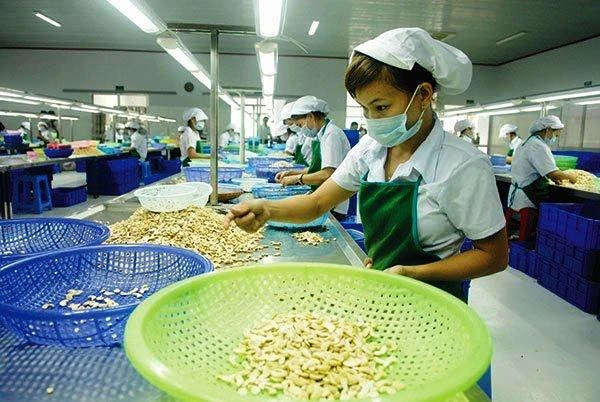
Not only did it decline in production and business activities, but LAF has almost "disappeared" from the stock market, as its stock got in warning status and suffered lack of liquidity.
Unable to gauge world cashew market
LAF, formerly known as Long An Export Company, was established in 1985, under the People's Committee of Long An Province. LAF was in the pilot equitizing program and was the fourth state-owned enterprise equitized in the Mekong Delta region. In 2000, LAF was one of the first 10 stocks listed on HOSE with reference price of VND 17,000/share.
As among the first companies listed on the stock market, LAF quickly became a "hot commodity" and set a peak of VND 82,500/share at the trading session on 25 June 2001. After this peak period, LAF held on to a long trading period at around VND 20,000/share. By 2007, along with an extremely impressive growth momentum in the stock market, LAF stock increased sharply to VND 52,500/share in the trading session on 12 December 2007.
However, since 2011, LAF has been in a difficult phase due to wrong predictions and assessment of the world cashew market. Especially, at the beginning of 2011, although the world cashew prices were rising at a high level, LAF still took the risk to borrow money from banks to buy raw materials for reserve. In fact, the material storage plan had helped LAF win big in 2010, thanks to the sharp increase in cashew prices by the end of the year. However, contrary to LAF's judgment, this time cashew prices unexpectedly plummeted at the end of 2011.
Despite being one of the top 10 largest cashew exporters in the country, the unexpected fluctuation in cashew prices drove LAF close to bankruptcy. The LAF stock was also negatively affected from these business results, falling to bottom at just over VND 3,000/share in 2012. Even, LAF stock stood to be canceled due to risk of losses exceeding its charter capital. It is noteworthy that in such difficult circumstances, LAF still maintained quite good transactions on the stock market with an average of thousands of shares per session.
Failed expectations
Difficulty for LAF rose after an opportunity was taken to acquire cheap shares by strategic enterprises encroaching on the agricultural field. One of them was a group of shareholders from Sai Gon Joint Stock Company (SSI).
In 2014, when the State Capital Investment Corporation (SCIC) decided to divest 23% of its capital in LAF, one member of SSI, Xuyen Thai Binh JSC (PAN), quickly gathered all these shares. PAN then transferred all of these shares to another member of SSI, PAN Food Joint Stock Company (Pan Food). PAN Food continued to gather shares from other member companies of SSI, raising its ownership to more than 80.5% (equivalent to 11.1 million shares).
PAN's acquisition of LAF was part of the goal of creating a foundation in the field of agriculture and foods, thereby completing the closed value chain from input to output products following the model “from farm to table”. With ambition and a model quite similar to LAF's core business, investors had high expectations for the "makeover" of this business after returning to the new owner with strong financial potential.
However, LAF's production and business activities did not show the positive changes that were expected. At the annual shareholders meeting in 2017, the Board of Directors of LAF aimed to overcome the accumulated losses arising from 2012, and had expected to eliminate all accumulated losses by 2018.
The fact that cashew prices fell sharply in the last months of the year compared to the cost of inventories at the beginning of the period, the price of raw materials purchased at the beginning of 2018 was at the highest level in five years, causing a sharp decrease in gross profit from sales of goods and services, and amounting to a negative profit.
Loss in liquidity
The explanation for the cause of the loss in 2018 once again showed that the Board of Directors of LAF were almost helpless in forecasting future cashew prices. For this reason, solutions to overcome the Board of Directors of LAF were just general measures, such as by reducing the output of raw cashew processing from imported raw materials; increasing production and proportion of high-class products; focus on arranging, investing in equipment, and closing the production lines; cutting production costs, management costs, and financial costs; and increasing labor productivity.
Unexpected business results also caused LAF to be continuously “blacklisted” at HOSE. Specifically, in 2013, LAF was put on alert because the after-tax profit in 2012 was negative at VND 152 billion. This warning was maintained until March 2019, after LAF was put under control due to accumulated losses at the end of 2018 amounting to VND 105.3 billion. With this decision, LAF could only trade in the afternoon session of the trading day by order matching method or agreement.
Recently, LAF was transferred by HOSE from control to the alert area thanks to its profit in the first six months of 2019 at VND 5.6 billion. However, this was not enough for LAF to regain investor confidence after showing continued losses, with doubt in abilities of the business leaders. This was also the reason for LAF to lose liquidity with only a few tens or hundreds of shares traded per session. There were even many sessions without any LAF buying orders being pushed up on the digital board.




















